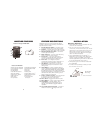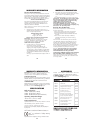
POP™ Mode
POP
™
Mode is a feature on some newer radar
guns operating on K and Ka bands. When the gun
is in POP
™
Mode and activated, a brief burst of
energy, less that 1/15 of a second, is transmitted
and the vehicle’s speed is quickly acquired. A
detector without POP
™
Mode detection capability
cannot respond to this brief transmission.
Laser Facts
It’s well documented that many radar guns
cannot reliably provide the speed of a targeted
vehicle that is traveling in a group of vehicles. In
contrast, a laser gun can target a specific vehicle
out of a line of traffic and determine its speed. The
advantage of laser over radar in terms of
target identification is the result of the laser gun’s
narrow beam. A radar gun’s transmission can
cover more than a four-lane highway at a distance
of 1,000 feet, compared with a laser gun’s
transmission which covers about 3 feet at the
same distance. For best protection, keep these
points in mind:
• Because the vehicle’s license plate or
headlights are the laser gun’s primar
y tar
gets,
mounting the Whistler detector on the
dashboard can improve laser detection at shor
t
range.
• Do not follow closely behind any vehicle you
cannot see through. If you can’t see past a
vehicle ahead of you, chances are your detector
can’t either.
• The receiving range of your laser detector will
not be the same as a radar detector. Laser guns
are most often used at short range.
Whistler Laser-Radar detectors receive all current
laser guns which operate at a laser wavelength of 905
+/- 10nm.
SPEED MONITORING
21
Laser T
ips
I
f you are the targeted vehicle, a laser gun can
o
ften determine your speed within a few
seconds after you receive an alert. In this
s
ituation, there is generally no time to safely
adjust your speed. However, if you are traveling
near or behind the targeted vehicle and receive
an alert
, response time should be sufficient. Any
laser alert, regardless of duration, requires
immediate action.
Radar Facts
A radar gun operates by transmitting radio
waves at certain frequencies which reflect off
objects and are picked up by the radar gun’s
receiving section. When a radar beam reflects
off a moving target, a measurable frequency shift
occurs. The radar unit converts this shift into miles
per hour to determine your vehicle’s speed.
Currently, the FCC (Federal Communications
Commission) permits operation of traffic radar
guns at X Band (10.500 - 10.550 GHz), K Band
(24.050 - 24.250 GHz), and Ka Band (33.400 -
36.000 GHz).
Note:
A radar detector will only alarm if an
of
ficer is transmitting on any one of the above
radar bands.
Other Speed Detection Systems
Several techniques other than radar or laser are
used to measure vehicle speeds. When these
methods are being used, no detector can provide
a warning. These techniques include:
•
P
P
a
a
c
c
i
i
n
n
g
g
- A patrol car drives behind you and
matches your driving speed.
•
V
V
a
a
s
s
c
c
a
a
r
r
/
/
A
A
i
i
r
r
c
c
r
r
a
a
f
f
t
t
- The police measur
e the time it
takes your vehicle to travel a known distance.
SPEED MONITORING
Radar Detector Detectors: VG-2,
Spectre
T
he Interceptor VG-2 or simply VG-2, is one type of
m
icrowave receiver used by Police to detect signals
radiated by the local oscillator of a radar detector.
B
ecause its purpose is to identify persons driving with
r
adar detectors, these devices are known as a “radar
d
etector detector” (RDD).
An RDD is the primary tool used by the police to identify
radar detector equipped vehicles. If caught in a state or
country where detectors are illegal (see page 20), drivers
risk losing their radar detector and receiving a fine. In
addition, instant-on radar is almost always used in
combination with an RDD, leaving unsuspecting
motorists vulnerable to receive two tickets; one potential
for speeding, and the other for possession of a detector.
Note: The newest tool Police have to detect radar
detectors is called Spectre. Spectre can detect the
majority of undetectable (VG-2) laser/radar detectors
on the market.
It is the responsibility of the individual radar detector
user to know and understand the laws in your area
regarding the legality of the use of radar detectors.
WARRANTY INFORMATION
Consumer Warranty
This Whistler Laser
-Radar detector is war
ranted to
the original purchaser for a period of three years from
the
date
of original pur
chase against all defects in
materials and workmanship. This limited warranty is
void if the unit is abused, modified, installed
improperly, or if the housing and/or serial numbers have
been removed. There are no express warranties covering
this product other than those set forth in this
warranty. All express or implied warranties for this product
are limited to the above time. Whistler is not liable
for damages arising from the use, misuse, or operation
of this
pr
oduct.
SPEED MONITORING
22 23











